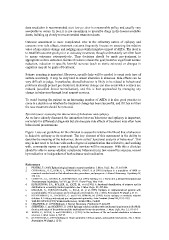Page 412 - ILAE_Lectures_2015
P. 412
dose escalation is recommended; start low go slow is a reasonable policy and usually very
acceptable to carers. In fact, it is not uncommon to prescribe drugs in the lowest available
doses, building up slowly to recommended treatment doses.
Outcome assessment is more complicated. Due to the refractory nature of epilepsy and
concerns over side effects, treatment outcome frequently focuses on assessing the relative
value of any seizure change and judging any potential negative impact of AEDs. The ideal is
to establish outcome goals prior to initiating treatment, though unfortunately we often have
to assess outcomes retrospectively. Thus decisions should be made pre-treatment to
appropriate seizure outcomes. Seizure freedom remains the goal; however significant seizure
reduction, reduction in specific harmful seizures (such as atonic seizures) or changes in
cognition may all be goals of treatment.
Seizure counting is important. However, specific help will be needed to count each type of
seizure accurately. It may be very hard to assess alteration in absences. Side effects can be
very difficult to judge. In particular, altered behaviour is likely to be related to behavioural
problems already present pre-treatment. Behaviour change can also occur when seizures are
reduced (so-called forced normalisation), and this is best approached by managing any
change in behaviour through local support services.
To avoid leaving the patient on an increasing number of AEDs it is also good practice to
come to a decision on whether the treatment change has been successful, and if it has not then
the new treatment should be removed.
Special issues: assessing the interaction of behaviour and epilepsy
As we have already discussed the interaction between behaviour and epilepsy is important,
not solely for differential diagnosis but also because side effects of treatment may often have
behavioural presentations.
Figure 1 sets out guidelines for the clinician to assess the relative likelihood that a behaviour
is linked to epilepsy or its treatment. The key element of this assessment is the ability to
describe the meaning of the behaviour, the so-called ‘functional analysis of behaviour’. This
may in fact need to be done with such a degree of sophistication that referral to, and working
with, community nurses or psychological services will be necessary. With this a clinician
should be able to assess whether a particular behaviour is in fact caused by seizures, caused
by medication or independent of both seizures and medication.
References
1. FRYERS, T. (1987) Epidemiological issues in mental retardation. J. Ment. Defic. Res. 31, 365-384.
2. COCKERELL, O.C., ECKLE, I., GOODRIDGE, D.M.G. et al (1995) Epilepsy in a population of 6000 re-
examined: secular trends in first attendance rates, prevalence, and prognosis. J. Neurol. Neurosurg. Psychiatry 58,
570-576.
3. CORBETT, J.A., HARRIS, R., ROBINSON, R. et al (1975) Epilepsy. In: J. Wortis (Ed.), Mental Retardation and
Developmental Disabilities, Vol VII, pp. 79-111. Raven Press, New York.
4. RICHARDSON, S.A., KOLLER, H., KATZ, M. et al (1981) A functional classification of seizures and its
distribution in a mentally retarded population. Am. J. Ment. Defic. 85, 457-466.
5. MARIANI, E., FERINI-STRAMBI, L., SALA, M. et al (1993) Epilepsy in institutionalized patients with
encephalopathy: Clinical aspects and nosological considerations. Am. J. Ment. Retardation 98 (Suppl.), 27-33.
6. STEFFENBURG, U., HAGBERG, G. and KYLLERMAN, M. (1995) Active epilepsy in mentally retarded
children. II. Etiology and reduced pre- and perinatal optimality. Acta Paediatr. Scand. 84, 1153-1159.
7. WELSH OFFICE (1995) Welsh Health Survey. Welsh Office, Cardiff.
8. CHADWICK, D. (1994) Epilepsy. J. Neurol. Neurosurg. Psychiatry 57, 264-277.
9. SHEPHERD, C. and HOSKING, G. (1989) Epilepsy in school children with intellectual impairments in Sheffield:
the size and nature of the problem and the implications for service provision. J. Ment. Defic. Res. 33, 511-514.
10. WEBB, D., FRYER, A. and OSBORNE, J. (1991) On the incidence of fits and mental retardation in tuberous
sclerosis. J. Med. Genet. 6, 395-97.
11. STAFSTROM, C. (1993) Epilepsy in Down syndrome: Clinical aspects and possible mechanisms. Am. J. Ment.
Retardation 98 (Suppl.), 12-26.

